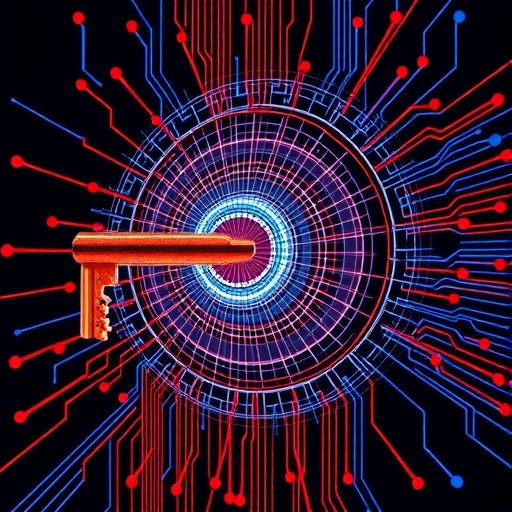In a groundbreaking advance within the field of quantum communication, researchers have experimentally demonstrated a composable key distribution protocol using discrete-modulated continuous variable (CV) quantum cryptography. This achievement marks a significant milestone toward practical, secure quantum networks that can withstand even the most powerful adversaries armed with quantum computational capabilities. The study, authored by Hajomer, Kanitschar, Jain, and colleagues, published in Light: Science & Applications, provides critical experimental validation for composable security in CV quantum key distribution (QKD) systems driven by discrete modulation schemes, which are known for their robustness and feasible implementation.
Quantum key distribution leverages fundamental principles of quantum mechanics to enable two parties to share a cryptographic key with security guaranteed against any eavesdropper limited only by the laws of physics. Among the many QKD protocols, continuous variable protocols, which utilize the continuous degrees of freedom of quantum states—such as the quadratures of coherent light—have emerged as a promising platform due to their compatibility with existing optical communication infrastructure. However, the translation of theoretical security proofs into experimental real-world systems remains a challenging frontier. The new study directly addresses this gap by implementing a composable security framework, ensuring that the security guarantees remain intact even when the protocol is integrated as part of a larger cryptographic system.
Traditional continuous variable QKD systems have often relied on Gaussian modulated states, which, combined with homodyne or heterodyne detection, require highly precise parameter estimation and state preparation. Discrete modulation, by contrast, uses a finite set of states, such as phase-shifted coherent states, which simplifies state generation and detection. The discrete modulation framework improves resistance against noise and losses encountered in practical channels. Despite these apparent strengths, formulating experimentally validated composable security proofs posed formidable challenges until now. The research team has successfully implemented such a protocol while carefully managing experimental imperfections, such as detector inefficiencies and channel losses.
.adsslot_56BHMlJOtz{ width:728px !important; height:90px !important; }
@media (max-width:1199px) { .adsslot_56BHMlJOtz{ width:468px !important; height:60px !important; } }
@media (max-width:767px) { .adsslot_56BHMlJOtz{ width:320px !important; height:50px !important; } }
ADVERTISEMENT
The essence of composable security is that the key generated by the QKD protocol can be securely combined with other cryptographic processes without compromising overall security. This is critical for real-world applications, where keys generated by QKD are used in combination with classical cryptographic schemes for tasks such as message encryption, authentication, and network key management. The current experiment verifies that discrete-modulated CV QKD satisfies these composable security criteria, under realistic settings characterized by finite-size key effects, channel noise, and imperfect devices.
A notable aspect of the research involves the implementation of an optimized discrete modulation format that balances complexity with security. By carefully selecting the constellation of coherent states, the authors have demonstrated that the security can be maintained with relatively low modulation complexity, addressing practical constraints in field deployments. The use of coherent light pulses modulated with discrete phases enables straightforward interfacing with telecommunications components, facilitating the integration of this technology into existing optical fiber networks.
Their experimental platform utilized state-of-the-art photonic components with high-speed modulation and detection systems, enabling the generation and measurement of quantum states at telecom wavelengths. Crucially, the researchers conducted comprehensive parameter estimation techniques to accurately characterize the quantum channel and optimize the key extraction process. The ability to maintain composable security under fluctuating channel conditions, including fiber attenuation and environmental noise, underscores the protocol’s robustness for metropolitan and longer-distance quantum communication.
The advances detailed in this study extend the practical horizon of CV-QKD towards real-world deployment by tackling several pertinent challenges in the field. One key obstacle overcome was the finite-key regime, where the number of quantum signals exchanged is limited, a typical constraint in operational scenarios. By employing advanced finite-size security analysis, the team ensured that the final secure key could be reliably distilled even with statistical uncertainties intrinsic to finite sample sizes.
Moreover, the integration of discrete modulation schemes with composable security framework represents a convergence of cutting-edge theoretical and experimental physics. Security proofs for discrete-modulated CV QKD necessitate intricate mathematical formulations that account for potential eavesdropping strategies, which include collective and coherent attacks. The validation of these proofs in practice is vital to instill trust in these emerging quantum cryptographic systems, and this work achieves precisely that by closing existing theoretical-experimental gaps.
Additionally, the reported protocol demonstrates resilience to excess noise—a common impediment in optical fiber transmissions—thus enhancing operational stability. Effective noise management strategies incorporated into the protocol mitigate vulnerabilities that might otherwise expose the system to sophisticated eavesdropping maneuvers. This robustness is especially critical as quantum networks move beyond laboratory conditions into turbulent real-world environments.
Underlying this breakthrough is the diligent synchronization of quantum state preparation and measurement, entailing fine calibration of modulator electronics, phase stabilization, and real-time data processing routines. The researchers employed rigorous error correction codes tailored for the discrete modulation format, coupled with privacy amplification techniques to distill secure keys from partially compromised data sets. This holistic approach integrates multiple layers of quantum and classical signal processing to deliver a practical, secure communication experience.
Looking forward, the experimental validation of composable security in discrete-modulated CV QKD opens numerous avenues for future research and deployment. High-speed implementations combined with multiplexing strategies could further boost secure key rates, while integration into quantum network nodes promises dynamic, on-demand secure connectivity across vast distances. As quantum technologies mature, protocols with proven security guarantees under realistic assumptions, such as the one reported, will undoubtedly become pivotal elements of the global quantum communication infrastructure.
In the broader context, this development contributes to fundamental progress in quantum information science by demonstrating that sophisticated theoretical models can be faithfully instantiated in complex photonic systems. The synergy between theory and experiment exhibited in this work sets a new standard for quantum cryptography research. By ensuring composable security, the approach guarantees that these protocols remain robust against future technological evolution, including the eventual rise of quantum computing adversaries.
Ultimately, the implications of this study reverberate well beyond optical physics laboratories. With cyber threats escalating and conventional cryptographic algorithms at risk from quantum attacks, the advancement of experimentally validated, composably secure quantum key distribution is critical for protecting digital infrastructure. The integration of discrete-modulated CV QKD into practical networks could herald a new era of cyber resilience, safeguarding communication from the quantum-enabled adversaries of tomorrow.
This pioneering achievement embodies a vital step on the journey towards ubiquitous quantum-secure communication, blending experimental finesse and rigorous security proofs into a compelling, deployable technology. As nations and industries race to build quantum-secure networks, the results reported by Hajomer and colleagues provide a scientifically sound, experimentally proven blueprint for establishing trust in quantum cryptographic devices built on continuous variable photonics.
Subject of Research: Composable key distribution using discrete-modulated continuous variable quantum cryptography.
Article Title: Experimental composable key distribution using discrete-modulated continuous variable quantum cryptography.
Article References:
Hajomer, A.A.E., Kanitschar, F., Jain, N. et al. Experimental composable key distribution using discrete-modulated continuous variable quantum cryptography. Light Sci Appl 14, 255 (2025). https://doi.org/10.1038/s41377-025-01924-9
Image Credits: AI Generated
DOI: https://doi.org/10.1038/s41377-025-01924-9
Tags: adversarial quantum computing resiliencecomposable security in quantum systemscontinuous variable quantum statescryptographic key sharingdiscrete-modulated continuous variable cryptographyexperimental validation of quantum protocolsimplementation of QKD systemsoptical communication infrastructure compatibilityquantum key distributionquantum mechanics principles in cryptographyrobustness of discrete modulation schemessecure quantum communication networks






